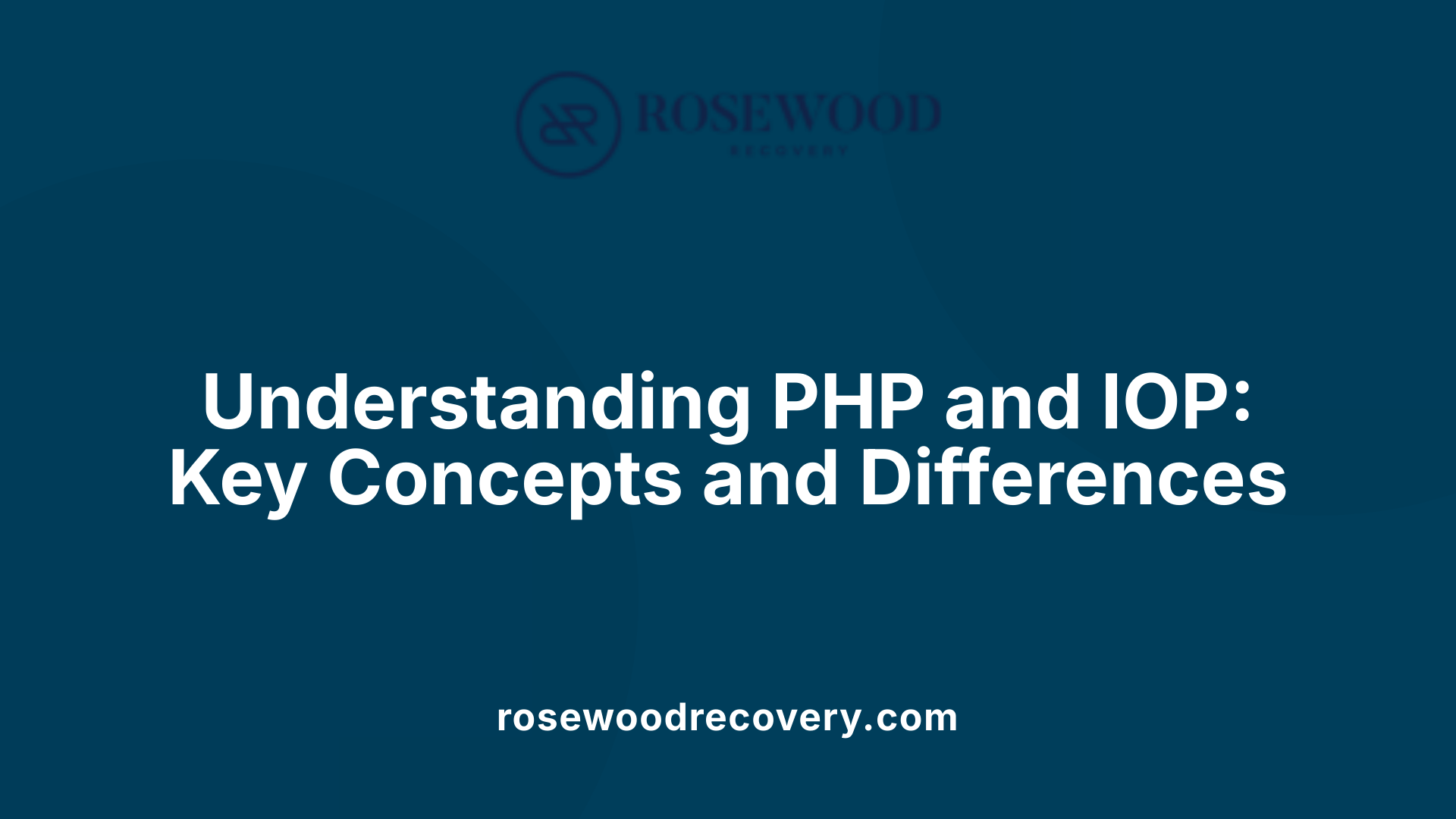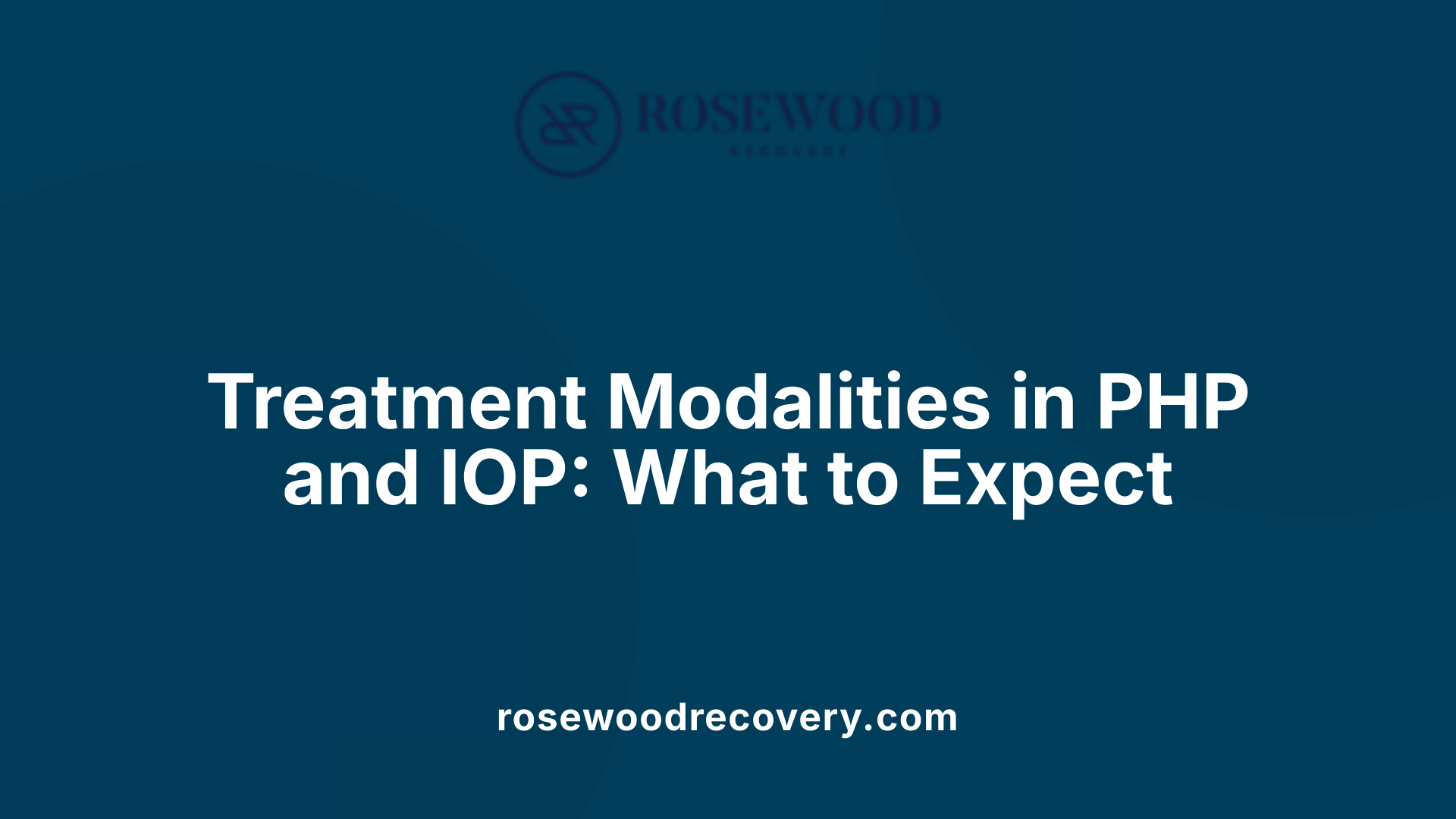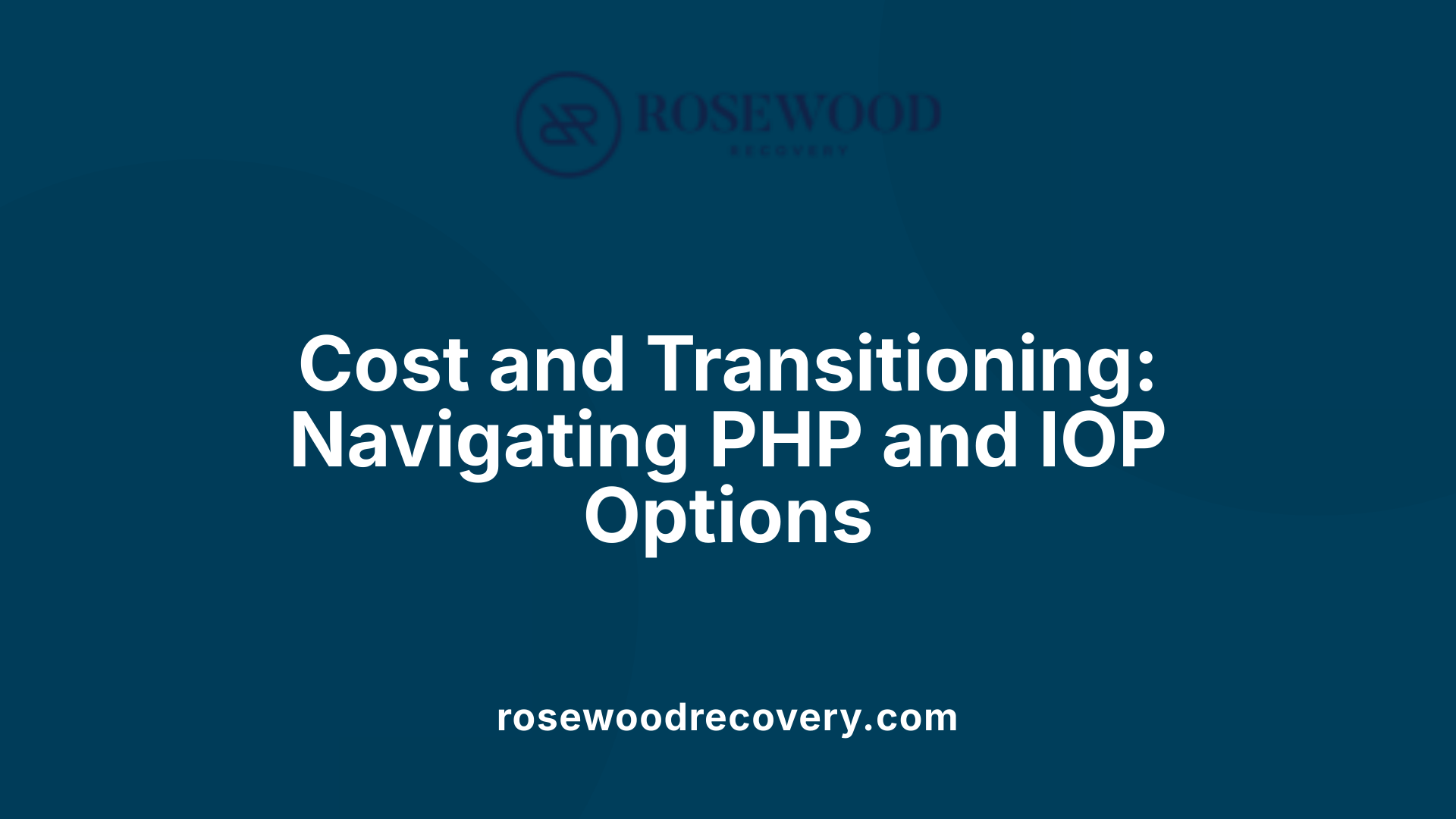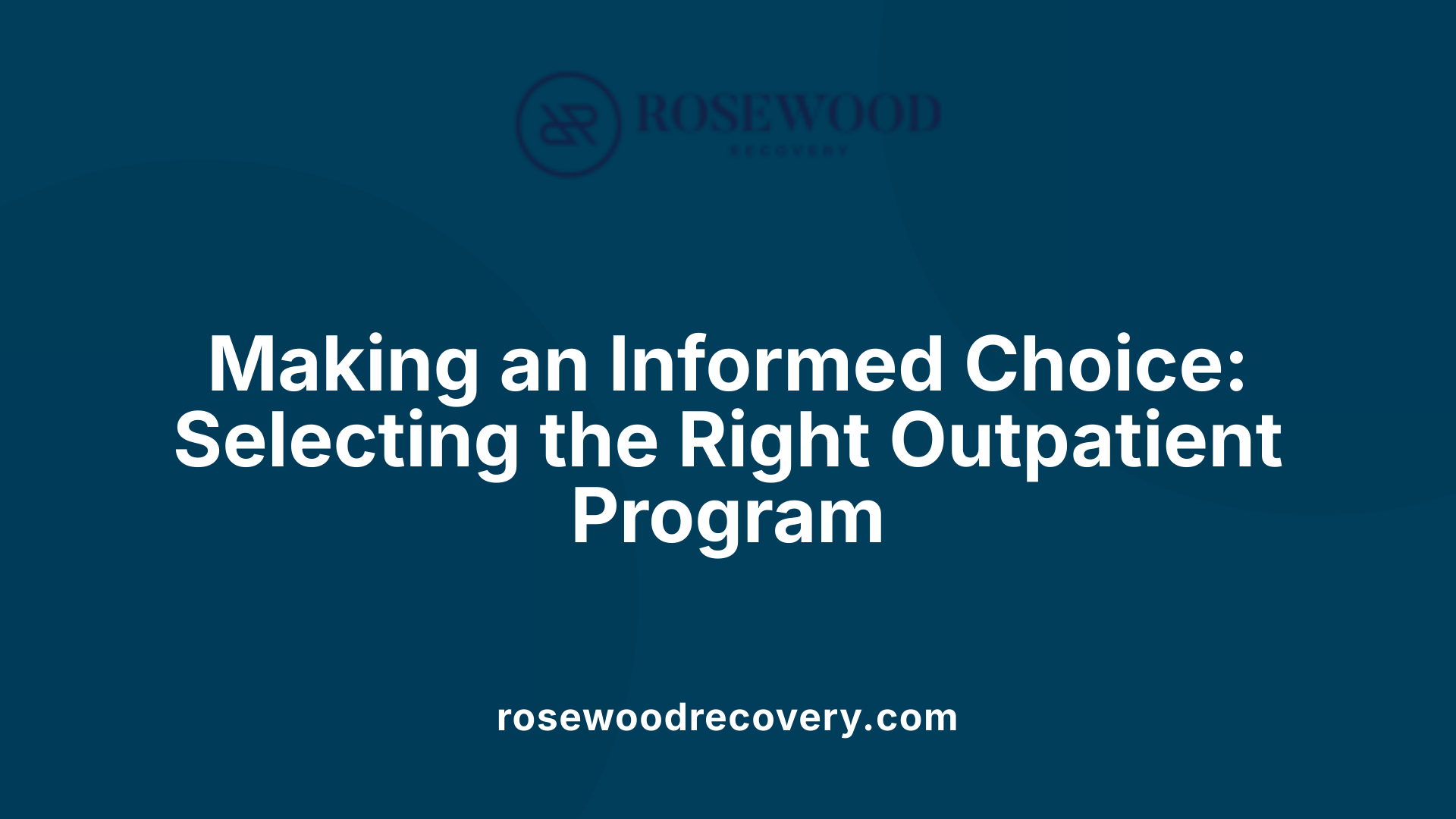What is the difference between PHP and IOP in addiction treatment
Understanding Outpatient Care: PHP vs. IOP

Introduction to PHP and IOP in Addiction Treatment
Partial Hospitalization Programs (PHP) and Intensive Outpatient Programs (IOP) are two prominent outpatient treatment options for addiction and mental health issues. While they share similarities in offering structured therapeutic care, they differ significantly in terms of intensity, duration, and suitability for different levels of severity. This article explores the core distinctions between PHP and IOP, providing insight into their features, structure, and appropriate patient selection, enabling individuals and families to make informed decisions about treatment options.
Defining PHP and IOP: Key Concepts and Purposes

What are PHP and IOP?
A Partial Hospitalization Program (PHP) is a structured mental health or addiction treatment service that provides intensive care during the day without requiring overnight stays. It usually involves attending sessions for about 4-6 hours daily, five or more days a week. These sessions include individual therapy, group therapy, medication management, and sometimes educational components tailored for different age groups, such as students.
In contrast, an Intensive Outpatient Program (IOP) offers a less demanding schedule, often involving 2-4 hours of therapy per day, three to five days a week. IOP provides similar therapy modalities—individual, group, family therapy, and psychoeducation—but with greater flexibility to accommodate daily responsibilities like work or school.
Core Purposes of Each Program
The primary goal of PHP is to stabilize patients experiencing more severe mental health or substance use issues. It acts as a bridge between inpatient hospitalization and outpatient care, providing intensive support to manage acute symptoms, help develop coping skills, and prevent relapse.
IOP aims to support individuals with milder symptoms or those transitioning from PHP or inpatient care. It focuses on reinforcing recovery strategies, developing life skills, and continuing therapy in a format that allows participants to maintain their daily routines.
Both programs strive to provide tailored, comprehensive care through evidence-based treatments such as Cognitive Behavioral Therapy (CBT), Dialectical Behavior Therapy (DBT), and family therapy. They serve individuals at different points in their treatment journey but share the common objective of fostering long-term recovery and stability.
Who Benefits from Each Approach?
PHP is well-suited for individuals with moderate to severe symptoms requiring close supervision and more frequent therapy sessions. It benefits those transitioning from inpatient care, those with complex mental health or substance use disorders, or patients needing high levels of support to maintain stability.
IOP is designed for individuals who have achieved some stability, have reliable support systems, and can manage daily responsibilities. It benefits those who have completed more intensive programs or inpatient stays, and who need ongoing support to sustain recovery without the intensity of PHP.
Choosing between PHP and IOP requires assessing the individual's severity of condition, level of support needed, daily commitments, and overall stability. Consulting mental health professionals can help determine the most appropriate treatment level for optimal outcomes.
| Program Type | Intensity Level | Typical Schedule | Main Focus | Ideal Candidates |
|---|---|---|---|---|
| PHP | High | 4-6 hours daily, 5-7 days a week | Symptom stabilization, medical oversight, intensive skills development | Severe mental health or addiction issues, those transitioning from inpatient care |
| IOP | Moderate | 2-4 hours daily, 3-5 days a week | Support for ongoing recovery, life skills, relapse prevention | Stable individuals, those with milder symptoms, recent program graduates |
| OP | Low | Varies, fewer hours, flexible scheduling | Maintenance and relapse prevention | Mild symptoms, low support needs, long-term stability |
Both programs are vital components of the continuum of mental health and addiction care. They incorporate a variety of evidence-based modalities, including individual and group therapies, family involvement, medication management, and behavioral therapies, to ensure comprehensive support for recovery.
Treatment Modalities and Structures in PHP and IOP

What common therapies are used in both programs?
Both Partial Hospitalization Programs (PHP) and Intensive Outpatient Programs (IOP) utilize a variety of evidence-based treatment modalities. Common therapies include individual counseling, group therapy, family therapy, and behavioral therapies like Cognitive Behavioral Therapy (CBT) and Dialectical Behavior Therapy (DBT). Medication management is also frequently incorporated, especially in PHP, to stabilize symptoms efficiently. These therapies aim to help individuals develop coping skills, manage their mental health conditions or substance use issues, and rebuild their social and family functioning.
How do session length and frequency differ?
The structure of sessions varies notably between PHP and IOP. PHP typically involves five days a week of treatment, with each day comprising 4 to 6 hours of structured activities. The total weekly hours in PHP range from 20 to 30 hours, offering a comprehensive and intensive support system. In contrast, IOP generally includes three to five therapy sessions per week, with each session lasting 2 to 4 hours. The weekly commitment in IOP is about 9 to 12 hours, providing more flexibility and allowing individuals to balance treatment with work, school, or family responsibilities.
What are the durations and goals of these programs?
PHP programs usually last between 2 to 6 weeks, focusing on stabilization, acute symptom management, and transitioning patients from inpatient care. The goal is to address urgent mental health or substance use issues in a highly structured environment, while gradually preparing patients for less intensive care.
IOP, on the other hand, often extends over several months—anywhere from 3 to 12 months—depending on individual needs. The primary aim is ongoing support, relapse prevention, and skills development to help maintain long-term recovery. IOP emphasizes helping patients integrate healthy coping strategies into their daily lives, ensuring sustained progress and stability.
Which patients are suited for PHP versus IOP?
PHP is ideal for individuals with moderate to severe mental health or substance use disorders who require intensive, multidisciplinary care. Patients often have complex needs, unstable conditions, or are transitioning from inpatient hospitalization. They benefit from the high level of supervision and support that PHP provides.
Conversely, IOP suits those with milder, stabilized conditions, including individuals who have completed PHP or inpatient treatment. These individuals typically have reliable support systems, stable living environments, and a motivation to stay on their recovery path while managing daily responsibilities.
Do PHP and IOP help in long-term recovery?
Research supports the effectiveness of both programs in supporting long-term recovery. PHP offers crucial initial stabilization, addressing immediate symptoms and reducing risks. IOP builds upon this foundation by fostering relapse prevention, life skills, and ongoing therapeutic engagement. When combined with other support systems like family involvement and sober living, both PHP and IOP contribute significantly to sustained recovery, improved social functioning, and reduced relapse rates.
Understanding the treatment structures and targeted patient profiles helps in choosing the appropriate program. Consulting with mental health professionals ensures that individuals receive tailored care suited to their specific circumstances and goals.
| Aspect | PHP (Partial Hospitalization) | IOP (Intensive Outpatient) | Additional Details |
|---|---|---|---|
| Session Frequency | 5 days per week | 3-5 days per week | Usually for 2-6 hours per day |
| Weekly Hours | 20-30 hours | 9-12 hours | Varies based on individual needs |
| Program Duration | 2-6 weeks | Several months to over a year | Short-term vs. long-term focus |
| Patient Suitability | Severe or unstable conditions | Mild or stabilized conditions | Transition from inpatient or ongoing outpatient care |
| Treatment Focus | Stabilization, acute symptom management | Maintenance, relapse prevention | Focuses on different phases of recovery |
| Level of Supervision | High, multidisciplinary support | Moderate, flexible support | Tailored to individual stability and needs |
Both PHP and IOP are important components of comprehensive mental health and addiction treatment. The choice depends on individual severity, stability, responsibilities, and recovery goals, underscoring the importance of professional assessment and personalized care planning.
Cost, Accessibility, and Transitioning Between PHP and IOP

Which program is more affordable, PHP or IOP?
Cost is an important factor when selecting a treatment program. A Partial Hospitalization Program (PHP) generally incurs higher expenses because it offers more intensive supervision, including comprehensive medical oversight, multiple daily sessions, and often additional services like medication management. Due to the level of care, PHP can be more costly on a weekly or overall basis.
In contrast, Intensive Outpatient Programs (IOP) are typically more budget-friendly. They require fewer hours of therapy each week—usually 9 to 12 hours—and involve less medical oversight. Because of this reduced intensity and supervision, IOP tends to be more accessible financially and is frequently covered by insurance plans, making it a practical choice for many individuals seeking treatment.
| Program | Average Weekly Hours | Cost Implication | Main Features |
|---|---|---|---|
| PHP | 20-30 hours/week | Higher | Intensive care, day-long sessions, medical monitoring |
| IOP | 9-12 hours/week | Lower | Flexible schedule, focus on therapy, skill-building |
Understanding these cost differences helps individuals and families plan for treatment expenses and explore coverage options effectively.
When should someone transition from PHP to IOP?
Transitioning from PHP to IOP is often part of a step-down process in treatment. Many patients move to IOP after showing signs of stabilization and when their symptoms reduce enough that they no longer need the full-day, highly supervised environment.
Common indicators for making this change include progress in therapy, increased stability, reduced risk of relapse, and the patient’s ability to manage daily routines with less oversight. Healthcare providers evaluate these factors regularly and recommend transitioning when it aligns with the patient's recovery goals.
This shift allows the patient to continue receiving essential support while gaining greater independence. The goal is to maintain the gains achieved during PHP and foster long-term recovery by gradually reducing treatment intensity.
Importance of professional assessment in program selection
Choosing between PHP and IOP should always involve a thorough assessment by medical or mental health professionals. These experts evaluate multiple aspects, including the severity of the mental health condition or substance use disorder, the patient’s stability, social environment, and support systems.
Based on this assessment, clinicians determine the appropriate level of care, which maximizes benefits and minimizes risks. For example, individuals with complex or severe symptoms may require PHP’s higher level of supervision, while those with milder conditions or strong support networks might be suitable candidates for IOP.
This personalized approach ensures that each person receives care tailored to their specific needs, improving outcomes and supporting sustainable recovery.
In summary, understanding cost considerations, knowing when to transition, and relying on professional guidance are crucial steps in navigating outpatient treatment options. These strategies help optimize recovery trajectories, making mental health and substance use treatment more effective and accessible for everyone.
Summary and Recommendations: Choosing the Right Program
How to assess individual needs and severity of condition
When deciding between a Partial Hospitalization Program (PHP) and an Intensive Outpatient Program (IOP), understanding the severity of the individual's mental health or substance use disorder is crucial. PHP is designed for those needing a higher level of support due to moderate to severe conditions. These individuals often require structured daily therapy, medical monitoring, and psychiatric care, but are stable enough to live at home. IOP, on the other hand, suits those with milder symptoms or who are transitioning from PHP or inpatient care. They typically have a safer home environment, reliable support systems, and can balance treatment with personal responsibilities.
Evaluation involves considering symptoms, risk factors, prior treatment history, and the presence of co-occurring disorders. Mental health professionals use assessment tools to determine whether a patient needs intensive supervision or can manage with less frequent, but consistent, outpatient care.
How to consult with healthcare professionals
Choosing the appropriate program requires thorough consultation with qualified healthcare providers. Professionals will evaluate the patient's overall health status, psychological stability, social support network, and specific needs. They consider factors like previous treatment outcomes, current level of functioning, and whether medication management is necessary.
During this process, open communication about expectations and goals is essential. The clinician can help weigh the benefits of each program, discuss potential challenges, and tailor recommendations that best suit the individual’s circumstances.
Additionally, ongoing monitoring and periodic reassessment are vital. Patients may start with PHP if their condition is severe and transition to IOP as they improve. Conversely, if someone in IOP experiences worsening symptoms, a shift to PHP might be warranted.
The role of personal circumstances and goals
Personal life circumstances greatly influence which treatment option is best. For example, individuals with jobs, educational commitments, or family responsibilities often prefer IOP for its flexibility. It allows them to attend therapy sessions while maintaining daily routines.
Conversely, those with significant mental health or addiction issues, frequent hospitalizations, or unstable living situations might need the intensive daily oversight provided by PHP.
Goals also matter—patients aiming for rapid stabilization or needing to address acute symptoms should consider PHP. Those focused on long-term recovery, skill-building, and relapse prevention may find IOP sufficient if their condition is less severe.
Balancing treatment intensity with personal goals ensures that individuals receive care that is both effective and manageable.
| Factors | PHP | IOP | Details and Implications |
|---|---|---|---|
| Symptom severity | Moderate to severe | Mild to moderate | Determines level of medical supervision |
| Daily hours of treatment | 4-6 hours, 5-7 days/week | 2-4 hours, 3-5 days/week | Impacts daily routine and commitments |
| Supervision and support | High, includes medical and psychiatric oversight | Lower, less medical oversight | Affects safety and monitoring levels |
| Flexibility and lifestyle | Less flexible, structured days | More flexible, supports daily responsibilities | Suitable for working or studying individuals |
| Cost considerations | Usually more expensive | Typically more affordable | Budget and insurance coverage are factors |
| Transition eligibility | Often for those requiring stabilization | Suitable for maintenance and relapse prevention | Long-term treatment planning |
When making a decision, involve healthcare providers to assess personal needs thoroughly. Both options aim to support recovery but differ significantly in structure and intensity.
For individuals seeking an effective pathway to recovery, professional guidance ensures they select the program that best matches their current condition, lifestyle, and recovery objectives.
For more guidance on choosing PHP or IOP based on individual circumstances, consulting reputable mental health resources and treatment guidelines is recommended. Tailored care plans enhance outcomes and help individuals achieve sustainable recovery.
Conclusion: Making an Informed Choice in Outpatient Care
 Choosing the appropriate level of outpatient care is a critical step in mental health and addiction treatment, and understanding the differences between PHP and IOP aids in making an informed decision.
Choosing the appropriate level of outpatient care is a critical step in mental health and addiction treatment, and understanding the differences between PHP and IOP aids in making an informed decision.
Summary of key differences: The primary distinction lies in the intensity and structure of the programs. PHP (Partial Hospitalization Program) provides a more intensive and supervised treatment environment, involving several hours of therapy each day, five to seven days a week. It aims to stabilize severe or complex conditions and often includes medical, psychiatric, and therapeutic interventions. IOP (Intensive Outpatient Program), on the other hand, involves fewer hours per week—typically 2-4 hours per session, three to five days a week—and focuses on ongoing recovery, relapse prevention, and developing life skills in a less restrictive setting. While PHP offers comprehensive support suited for acute needs, IOP emphasizes flexibility, community reintegration, and maintaining daily responsibilities.
Importance of personalized treatment planning: It cannot be overstated that every individual’s circumstances and treatment needs differ. Professional assessment by mental health and addiction specialists ensures that patients are placed in a program aligned with their symptoms, stability, and support systems. Factors such as severity of symptoms, mental health history, past treatment success, and current living conditions are considered vital for customizing an effective pathway. This personalized approach not only enhances the likelihood of recovery but also reduces the risk of relapse, hospitalization, or treatment dropout.
Encouragement to seek professional advice: Optimal treatment outcomes depend on expert guidance. Consulting with qualified professionals helps determine whether PHP, IOP, or another level of care is appropriate. They evaluate individual needs, support availability, and life circumstances to recommend a tailored treatment plan. This collaborative decision-making process ensures that individuals receive the right care at the right time, supporting their journey toward recovery.
| Aspect | PHP (Partial Hospitalization Program) | IOP (Intensive Outpatient Program) | Additional Notes |
|---|---|---|---|
| Level of Care | Higher | Moderate | Based on severity and needs |
| Schedule | 20-40 hours weekly | 9-12 hours weekly | Based on individual circumstances |
| Supervision | High, with medical oversight | Less, focused on therapy | Varies with stability |
| Focus | Stabilization, managing acute symptoms | Support, relapse prevention | Supports ongoing recovery |
| Suitability | Moderate to severe disorders, transitional support | Mild to moderate, stability achieved | Reflects individual condition |
| Cost | Usually more expensive | More affordable, often covered by insurance | Budget considerations |
| Environment | Highly structured, often on-site | Flexible, community-based | Depends on personal preferences |
Choosing between these options should be guided by a comprehensive assessment and personalized care planning. Engaging with healthcare professionals ensures the most suitable and effective treatment pathway, ultimately increasing the chances of long-term recovery.
Final Thoughts on Choosing Between PHP and IOP
Selecting the appropriate outpatient treatment program—whether PHP or IOP—is a pivotal step in the recovery journey. The decision hinges on the individual's diagnosis, severity of symptoms, personal circumstances, and goals for treatment. PHP offers intensive, structured care suitable for acute phases or severe conditions, providing medical and psychiatric oversight necessary for stabilization. IOP, with its flexible schedule, caters to those with milder symptoms, stable environments, and ongoing recovery needs. Consulting with healthcare professionals to conduct a thorough assessment enables patients to choose a program that best supports their recovery, minimizes relapse risk, and promotes long-term well-being. Recognizing that both PHP and IOP are valuable tools within the continuum of care underscores the importance of individualized treatment planning—ensuring each person finds the level of support they need for a successful recovery.
References
- PHP vs IOP | Charlie Health
- PHP vs IOP: What's The Difference? - The BridgeWay
- PHP vs IOP Treatment: Which is Right for You? - CBH
- PHP vs IOP: What's The Difference? | Arrowhead BH
- PHP vs. IOP: Understanding the Difference
- PHP vs IOP: What's the Difference? - Three Rivers Behavioral Health
- How IOP and PHP Work Together to Ensure Long-Term Recovery ...
- IOP vs. PHP – what's the difference? | Symetria Recovery®
- What's the Difference Between PHP, IOP, and OP?
- IOP vs PHP: Navigating Addiction Treatment Choices
More Articles
Recovery Begins Here
Click below to get in touch and schedule a consult call with our team to begin your journey towards happiness and freedom.
Rosewood Recovery does not discrimate against any person because of the race, color, religious creed, ancestry, age, sex, sexual orientation, gender identity, national origin, handicap or disability or the use of a guide or support animal because of the blindness, deafness or physical handicap.





